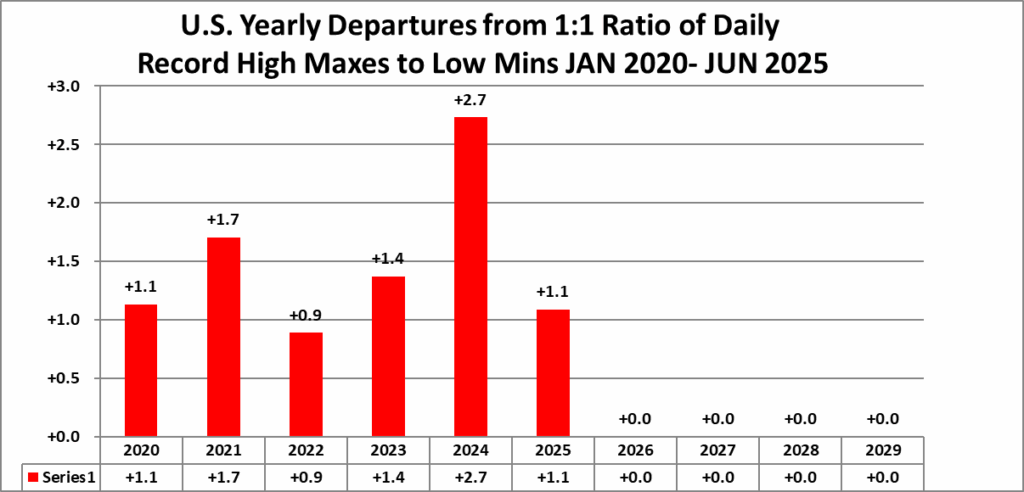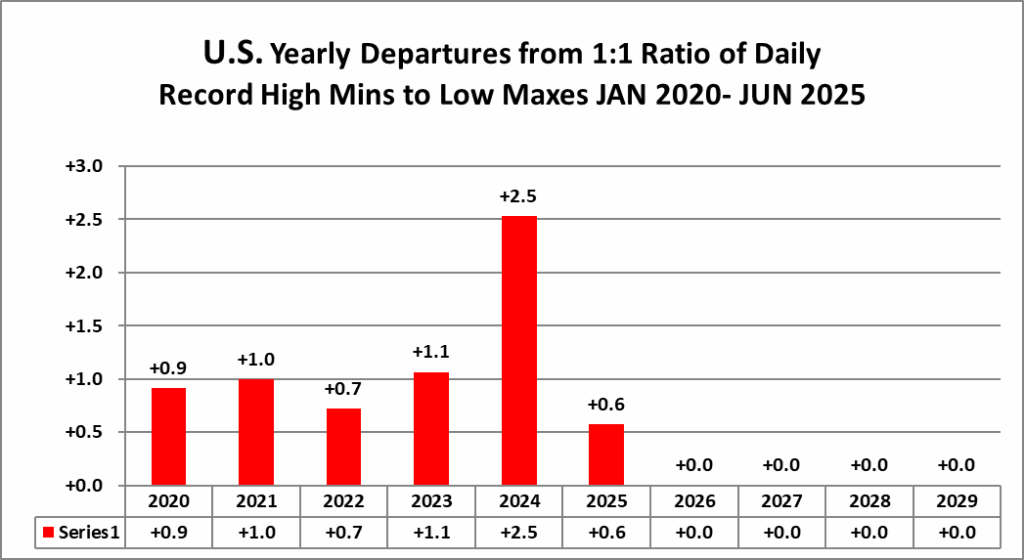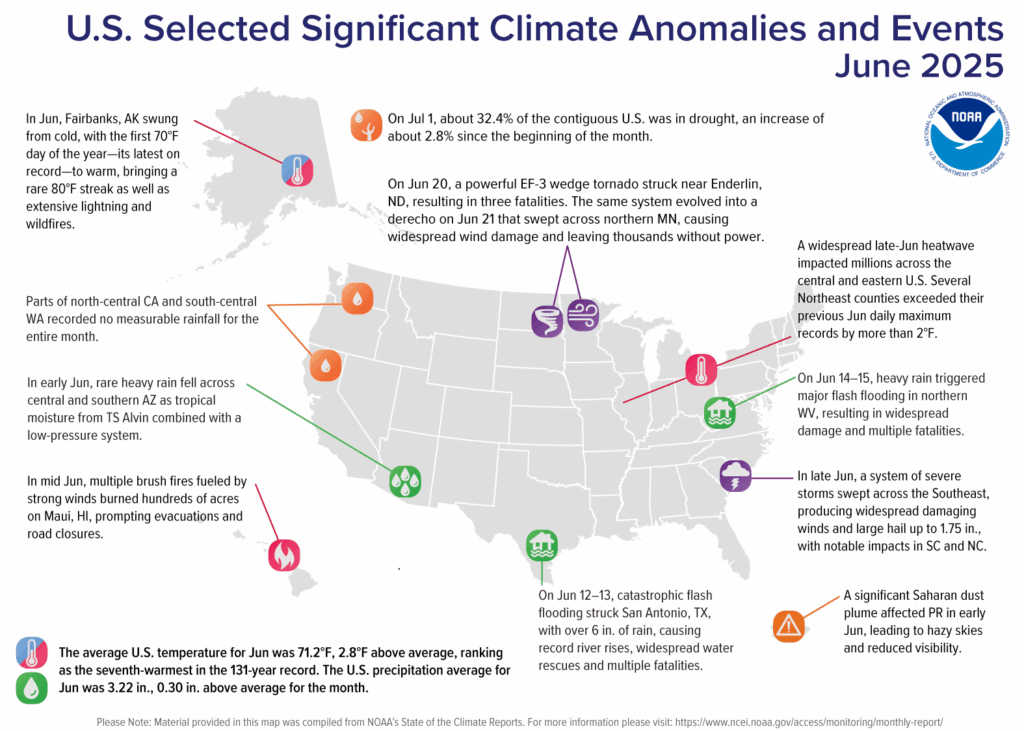The main purpose of this ongoing blog will be to track planetary extreme, or record temperatures related to climate change. Any reports I see of ETs will be listed below the main topic of the day. I’ll refer to extreme or record temperatures as ETs (not extraterrestrials).😉
Main Topic: U.S. June 2025 Record Scoreboard and Climatological Review
Dear Diary. It’s time for our monthly climatological review. Here on this site, we usually present monthly summaries near the 10th of each month, and each is available by clicking the link below:
https://guyonclimate.com/category/record-scoreboard-climatological-reviews
I’m repeating this mantra every month:
June 2025 got ranked by the National Center for Environmental Information for the lower 48 states as 7th warmest or 125th coolest since records began being kept in 1895 at +2.75°F above the 1901-2000 average.
The above data was from:
https://www.ncdc.noaa.gov/cag/national/rankings

During June the warmest conditions were in the western and eastern portions of the nation. A few central states had near average temperatures. Most reports of record chill came from the Midwest during the middle of the month. Most reports of record warmth occurred in the West early in the month with the bulk coming from the East due to historic CAT4 Heatwave Shell during the third week of June. So far 88 all-time record reports can be credited to Shell.
You can check out record totals for yourself on my NCEI record archives:
NCEI Record Count Archive – Guy On Climate
Here are my two U.S. Daily Record Scoreboards updated through 7/09/2025 (data compiled from the following NCEI site):
https://www.ncdc.noaa.gov/cdo-web/datatools/records
I’m also keeping tabs on record report totals to verify a scientific study I helped to complete in the decade of the 2000s. We’ll eventually see how skewed ratios of record warm to cold reports get by the year 2100, which the study mentions as 50-1 for DHMX vs. DLMN:


DHMX= Daily High Max Reports. DLMN= Daily Low Min Reports. DHMN= Daily High Min Reports. DLMX=Daily Low Max Reports.
Boldly highlighted red, blue, or purple colored months, such as December 2023 and June 2021, that have ratios of >10 to 1 daily or <1 to 10 of daily warm to low records are either historically hot or cold, most of which have made news. NCEI rankings are for the lower 48 states with the warmest ranking since 1895 of average temperatures being 131 and 1 being the coldest as of 2025. Blue colors represent cold months and red warm. Those months and years with counts close to a 1 to 1 ratio of highs to lows are colored black. All-time record hottest or coldest months and years are boldly colored in purple. NCDC rankings have been color coded (under tabs in each file) such that values of 55 to 75 are black representing neutral months or years (+ or – 10 from the average ranking of 64).
Totals are record reports for the entire United States including all territories minus those from Alaska. I’ve subtracted those from Alaska to get a better representation of what has occurred across the lower 48 states in association with lower 48 state rankings.
June 2025 had approximately a 56 to 15 ratio of record DHMX to DLMN individual record counts, so the color I used for that month was red on the top chart.
June 2025 had approximately a 42 to 13 ratio of record DHMN to DLMX individual record counts, so the color I used for that month was red on the bottom chart.
Due to climate change, we are seeing fewer blue colors on these Record Scoreboards with time.
The average temperature lower 48 state ranking June 2025 was 125, which was colored red since it was warmer than average. We are seeing fewer blue colors on my charts, and June 2025 was yet another red or warm month.
I color rankings of +10 to -10 from the average ranking for the lower 48 states of 65 black, indicating that these are near average temperature wise. The top warmest ranking for 2024 would be 130 since rankings began in 1895.
Looking at the type and number of record reports, July 2025 has gotten off to a hot start, and meteorological models are consistently forecasting an above average July for temperatures. We did see a top 10 warmest June. Will we see a historic top 10 warmest July? Stay tuned.
Interestingly, here is what we see as far as overall yearly ratios go for the 2020s so far. Warmth is key here:


Here is much more detailed climatology for the June 2025 as complied by NOAA:
https://www.ncei.noaa.gov/news/national-climate-202506
Assessing the U.S. Climate in June 2025
Summer’s arrival was marked by a widespread June heatwave; dry conditions in the Northwest contrasted with wet conditions in the central and southern U.S.

Published
July 9, 2025
Key Point:
A widespread late-June heatwave impacted much of the central and eastern U.S., and brought record-setting temperatures. More than 100 million people across 726 counties experienced record heat from June 22–25.

Map of the U.S. selected significant climate anomalies and events in June 2025
Other Highlights:
Temperature

June U.S. Mean Temperature Departures from Average Map
The average temperature for the contiguous U.S. (CONUS) in June 2025 was 71.2°F, 2.8°F above the 20th-century average, and ranked seventh warmest in the 131-year record. Temperatures were above average across most of the Lower 48, with much-above-average warmth affecting large areas of the western third of the country, along with parts of the Florida Peninsula, Mid-Atlantic, Northeast and Great Lakes regions. Rhode Island saw its second-warmest June on record and its warmest for nighttime minimum temperatures, which were 5.8°F above average.
Alaska’s average temperature for June was 50.8°F, 1.6°F above the long-term average and ranking in the warmest third of the 101-year record. While parts of the southeast Panhandle were slightly cooler than average, the North Slope was notably warm at more than 3 degrees above average.
The average temperature for the CONUS during the first half of 2025 (January–June) was 49.6°F, 2.1°F above the 20th-century average, ranking in the warmest third of the 131-year record. All states recorded temperatures above their long-term averages for the six-month period, with much-above-average warmth observed across parts of the West, Southwest and portions of the East Coast. Alaska’s year-to-date average temperature was 26.8°F, 5.5°F above its long-term average, tying as the fourth-warmest January–June in the 101-year record.
Precipitation

The average precipitation for the contiguous U.S. in June was 3.22 inches, 0.30 inch above the long-term average, ranking in the wettest third of the 131-year record. Much of the Southwest, the southern and central Plains, the middle and upper Mississippi Valley, parts of the Ohio Valley and Great Lakes region and areas of the Deep South recorded above-average rainfall. In contrast, drier-than-average conditions prevailed from the central West Coast through the Northwest and into the Rockies. The Northwest region experienced its third-driest June on record—and driest since 2003—with Washington and Oregon each receiving less than half an inch of rain for the month. Parts of north-central California and south-central Washington recorded no measurable rainfall for the entire month.
For the January–June period, the CONUS averaged 15.70 inches of precipitation, 0.40 inch above the long-term average, ranking in the middle third of the 131-year record. Most of the western half of the country, along with a narrow band from the central Plains through the mid-Mississippi Valley and parts of the Southeast, were drier than average. Above-average precipitation was recorded from the southern Plains through the lower Mississippi and Ohio Valleys into the Northeast, as well as in parts of the northern Plains and upper Mississippi Valley.
Alaska received 2.32 inches of precipitation in June, which was near the long-term average. Conditions were drier than average across the eastern interior and North Slope but wetter than normal in the western and southwestern parts of the state. For the first half of the year, Alaska recorded 16.58 inches of precipitation, 2.96 inches above average, marking its fifth-wettest start to the year on record.
Drought
According to the July 1 U.S. Drought Monitor report, about 32.4% of the contiguous U.S. was in drought, an increase of approximately 2.8% since the beginning of the month. Drought developed or intensified across much of the Northwest through the Rocky Mountains and in small areas of the Alaskan interior. Conversely, drought contracted or was reduced in intensity across parts of the Southwest and southern Texas, the central and northern Plains, the upper Mississippi Valley and parts of Florida.
Monthly Outlook
July temperatures are expected to be above normal across the entire contiguous U.S., with the highest likelihood of warmer-than-average conditions in the Mountain West, southern Texas and throughout much of the Great Lakes and the Northeast. For rainfall, parts of the Northwest and the southern and central Plains are expected to be drier than normal, while the interior East is favored to have a wetter-than-average July. Drought is likely to persist across much of the western U.S. in July, with some further development in the Northwest, while improvement is expected across southeastern Arizona, southern New Mexico and far West Texas, where above-average rainfall is favored.
Visit the Climate Prediction Center’s Official 30-Day Forecasts and U.S. Monthly Drought Outlook website for more details.
Significant wildland fire potential is above normal for July across the Northwest, Hawaii and Puerto Rico. For additional information on wildland fire potential, visit the National Interagency Fire Center’s One-Month Wildland Fire Outlook.
For more detailed climate information, check out our comprehensive June 2025 U.S. Climate Report scheduled for release on July 14, 2025. For additional information on the statistics provided here, visit the Climate at a Glance and National Maps webpages.
Here are more “ET’s” recorded from around the planet the last couple of days, their consequences, and some extreme temperature outlooks, as well as any extreme precipitation reports:
Here is More Climate News from Wednesday:
(As usual, this will be a fluid post in which more information gets added during the day as it crosses my radar, crediting all who have put it on-line. Items will be archived on this site for posterity. In most instances click on the pictures of each tweet to see each article. The most noteworthy items will be listed first.)
More from the Weather Department:
Today’s News on Sustainable Energy, Traditional Polluting Energy from Fossil Fuel, and the Green Revolution:
More on the Environment, Nature and Science:
If you like these posts and my work on record temperature ratios, please contribute via my PayPal widget on this site. Thanks in advance for any support.
Guy Walton… “The Climate Guy“
Related Links
June 2025 U.S.Climate Report (Available July 14, 2025)
National Temperature and Precipitation Maps
Climatological Rankings Explained